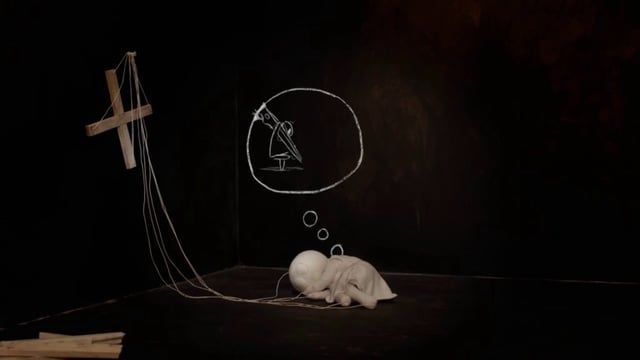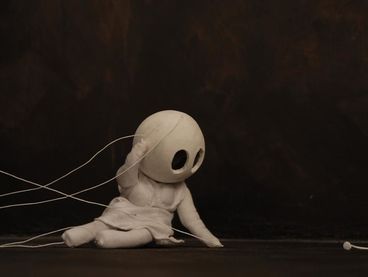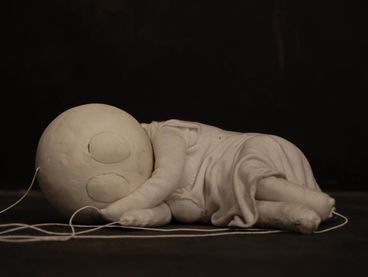MOOZ – audiovisual arts collection
L'affranchie
2010, 7:58 min., color
Direction, idea, animation, editing and music: Pauline Flory
Sounds: Jie Lu
Sound design: Kabelton
Advisors: Prof. Raimund Krumme, Stéphanie Beaugrand
Production: Academy of Media Arts Cologne
A marionette sleeps and dreams that she is freed from her strings and crossbar. But true freedom requires courage and will.
Interview with Pauline Flory
You initially studied drawing and painting, how did you come to work in animation?
After graduating high school (Abitur) I studied at the École Estienne in Paris, earning a degree with a focus on copperplate engraving. At the time I wanted to work in the field of illustration or graphic design. I have always liked telling stories and at some point I realized that “still images” weren’t enough for me anymore. I wanted to tell my stories with time, movement, and sound. Thus I slowly arrived at animation. I am still however very much shaped by my original area of study, for example, I like to work with lettering, which was at the time very important in my illustration work. Traditional drawing materials like paper, pencils, or charcoal are very present in my work. I prefer animating “analog,” and I like to get my hands dirty! I now no longer view my painted images as individual works, but rather as image sequences or as film.
How would you describe your working process?
I don’t (yet?) have a working process. There are of course stages that repeat, but that is not always conscious or intentional. I often begin with a character. I have many sketchbooks that I often draw in. Sometimes I focus in on a sketch that later evolves into a character. Then I ask myself what story could I tell with or more precisely about this figure. The third step is to find the right technique that will best tell this story. For L’affranchie I wanted to work with a marionette, because this object was fascinating to me and it has a very strong metaphorical potential. Through the marionette I came to the themes of freedom and willpower. In the film there are two marionettes, one that is dreamed and one “real” marionette. I drew the animation for the marionette in the dream: this is the free and strong-willed marionette. Which is also how I see the technique of drawn animation. Here really anything is possible; one has to make decisions and create a framework for themselves. The “real” marionette is made with stop-motion: this is the hesitant and inhibited marionette. The technique of stop-motion is likewise more limited. Depending on how the figure is built, some movements are possible and some just aren’t. This was the first time that I worked with stop-motion, although it is not my favorite technique. But I thought it was appropriate for this story. I should also mention that it was very fun. You have to really work with the figure, physically too (to a certain extent, I had to get on all fours on the stage to animate the figure). The figure became a real partner in the process, but when turning out the lights after filming and suddenly the figure lies lifeless on the stage, it is really strange.
What is especially important for you in the process of animation?
I am interested mainly in the movements: what stories can you tell through movement? For example, I don’t like animations in which there is a lot of speaking. I always wonder whether a particular story perhaps could be better told with live actors. If so, there’s no reason to make an animation out of it. And if one chooses to make an animation, one should also make use of its particular characteristics and possibilities. In animation one does not need to explain everything or have everything be credible. You can create a fantasy world and determine the logic of it yourself. That is a lot of freedom and at the same time a lot of responsibility.
How do you achieve the expression of emotion in your characters? How important are small gestures and details?
Emotions are created through movements and behavior. My characters are almost always silent and the faces are very simple and stylized. In L’affranchie the face of the figure does not change. Her feelings are conveyed through her physical manner. In order that a character comes across in a particular way, one should consider how they behave. The way they behave towards other characters can also help to express emotions. In my degree project film Le Nombril the main character (a penguin) is accompanied by a supporting character (a snake). The theme of the film is the search for identity. The supporting character helped a lot in expressing the emotions and the personality of the main character. When one is completely alone, you don’t need to think much about identity. The penguin is a cheerful and curious character. He is like a small child and also moves like a child: he is spontaneous, a little clumsy, friendly and not cautious, he likes to learn… His movements are evocative of a cross between a child and a penguin. I try to develop each character’s own (physical) language.
Your characters seem to always be on a search for something. Is this a theme for you?
When I look at my work I notice that it generally deals with existential questions. Dreams and sleep are also often present. But I would still not say that these are my themes, because I don’t develop a story around a certain theme. It is just something that I observe afterward and that I don’t necessarily do consciously. I think that my “themes” are the questions that occupy me in the moment. In my film Le Nombril it’s about the search for identity. Now having some distance from it, I notice that I have been focused on the question of identity since I have been in Germany. Since I have been away from my family and country, I have come to get to know myself better. Probably that is why this theme appears in my degree film. But, as I said, when I am working on a project, I don’t have enough distance to recognize this process. In my film Rendezvous mit einer Toten [Rendezvous with the departed], which was produced with 3sat for the themed program Bruder Tod [Brother death], it was a little bit different. I was developing a film on the theme of death, which was, at the time, not at all a theme that I was interested in. So I tried to engage with this topic and looked at death as loss. But, yes, the idea of the “search” is definitely a good summary of my work. I am myself constantly searching; I am always a bit unhappy with my work and exactly because of this I keep going and hope that the next film will be better!
What significance does sound or speech have for you in your animations? Is the sound the language of your characters? Does this language emerge in connection with the movements in your animation?
Sound is one of the reasons that I work in animation. I played piano and guitar for years, unfortunately I was not especially talented. It is nevertheless still very important in my life and work. For the film L'affranchie I did the sound myself, because I really wanted to try it out. In Le Nombril I was lucky to work with a very good composer and sound designer (Alexander Zlamal). In contrast to live-action films, in animated films there is no existing sound; one has to invent everything, which means of course that there are unlimited possibilities. Basically I try to work with the music and sound design together and not keep them separate. The sound plays an important role and should not be just illustrative. Images and sound should communicate with each other in order to create a new direction or mood. I also try not to overload the images with too much sound; I find that silence is also an important part of sound and it can convey emotion. My film Rendezvous mit einer Toten, for example, has no music; the soundtrack is made up of only sounds and noises. In this way the film comes across more intensely and the viewer is not manipulated by artificial music, with death being the already emotional theme of the film. I make sure that the character is supported by the sound design and effects—that through the sound it gains in personality. Apart from that sound is a great way to represent a fictive space and a fantasy world. After working so long with the images it is very thrilling to see the film for the first time with the scoring, it is like a transformation.
How has it been going forward working in animation after your studies? Are there also opportunities to do contract work?
It is not at all easy to combine the creative with the financial in animation. I am still at the beginning in all of this, but it is at the same time very exciting. It is slowly developing and even those times when I have financial difficulties, I am happy to be able to realize my passion. This is of course also a life decision and I stand by it. I am also working with children in workshops, for example, which I always find very exciting and interesting. Today children are totally overburdened with moving images—but one can still teach them to distance themselves and be critical. This is important, and children like it when they are taken seriously. This personally gives me hope for the future in the film and television industry, and it gives me strength to continue doing my work.
More on Pauline Flory and her artistic work can be found here: www.paulineflory.eu
Pauline Florywas born in 1981 in Saint-Germain-en-Laye, France. She lives and works in Cologne. Undergraduate studies at the Academy of Media Arts, Cologne, from 2005 to 2011. She earned her degree in film with the animated film Le Nombril.








